Management of Peritonitis
VerifiedAdded on 2023/06/10
|10
|2868
|263
AI Summary
This case study discusses the causes, symptoms, and treatment of peritonitis in a patient with a ruptured appendix. The essay applies clinical reasoning cycle to offer person-centered care to the patient. The three priority problems in the case study include: treatment to rectify the abdominal pain, raised White Blood Cells (WBC) and nausea.
Contribute Materials
Your contribution can guide someone’s learning journey. Share your
documents today.
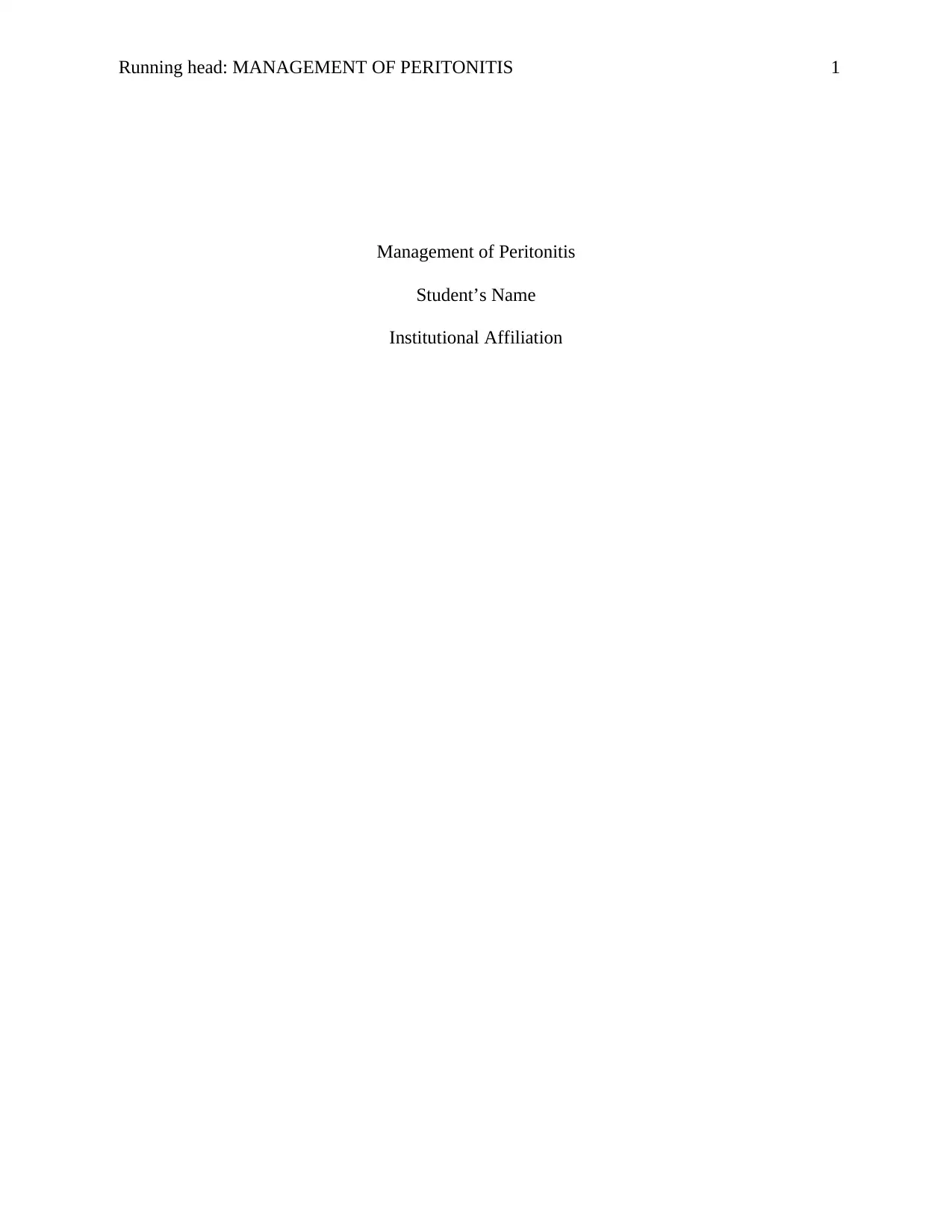
Running head: MANAGEMENT OF PERITONITIS 1
Management of Peritonitis
Student’s Name
Institutional Affiliation
Management of Peritonitis
Student’s Name
Institutional Affiliation
Secure Best Marks with AI Grader
Need help grading? Try our AI Grader for instant feedback on your assignments.
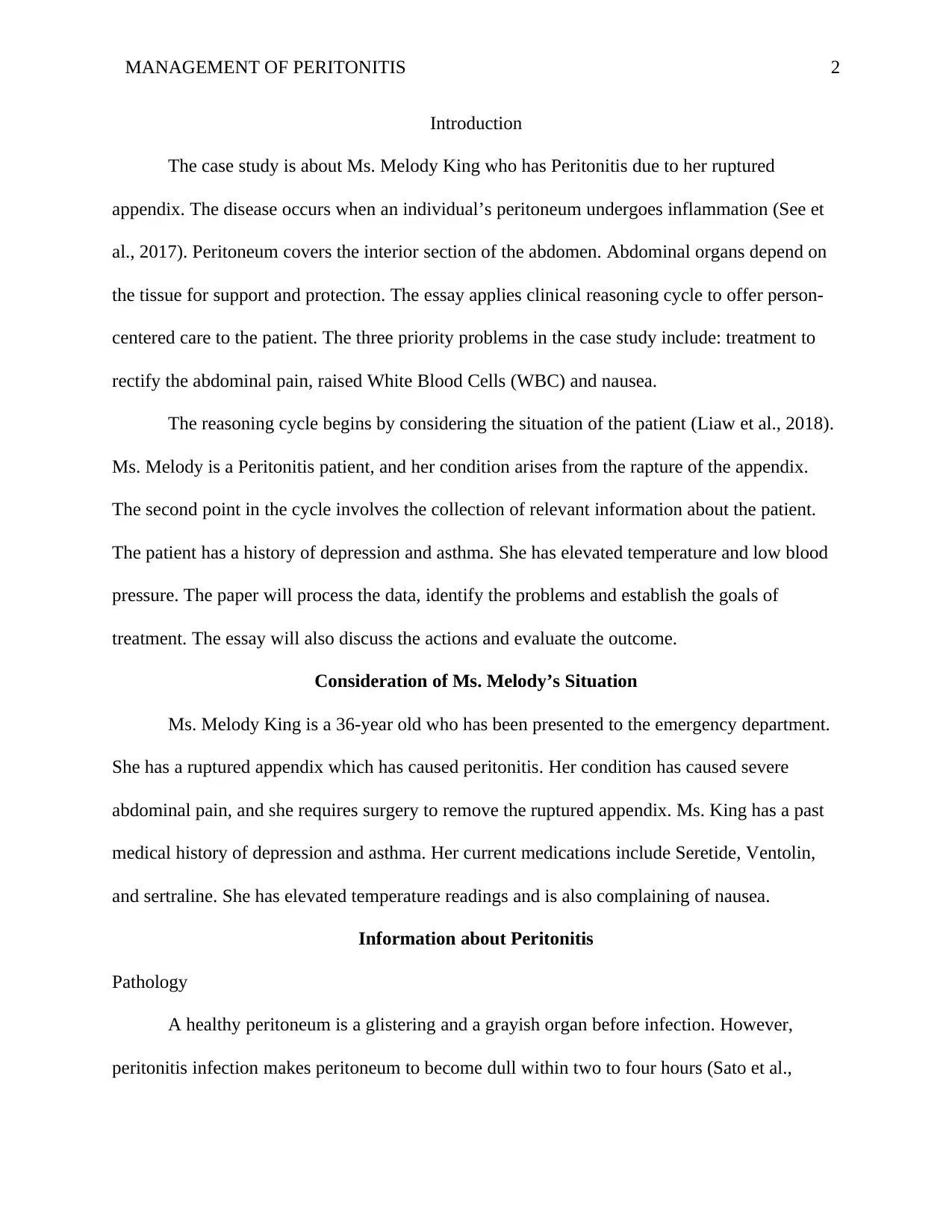
MANAGEMENT OF PERITONITIS 2
Introduction
The case study is about Ms. Melody King who has Peritonitis due to her ruptured
appendix. The disease occurs when an individual’s peritoneum undergoes inflammation (See et
al., 2017). Peritoneum covers the interior section of the abdomen. Abdominal organs depend on
the tissue for support and protection. The essay applies clinical reasoning cycle to offer person-
centered care to the patient. The three priority problems in the case study include: treatment to
rectify the abdominal pain, raised White Blood Cells (WBC) and nausea.
The reasoning cycle begins by considering the situation of the patient (Liaw et al., 2018).
Ms. Melody is a Peritonitis patient, and her condition arises from the rapture of the appendix.
The second point in the cycle involves the collection of relevant information about the patient.
The patient has a history of depression and asthma. She has elevated temperature and low blood
pressure. The paper will process the data, identify the problems and establish the goals of
treatment. The essay will also discuss the actions and evaluate the outcome.
Consideration of Ms. Melody’s Situation
Ms. Melody King is a 36-year old who has been presented to the emergency department.
She has a ruptured appendix which has caused peritonitis. Her condition has caused severe
abdominal pain, and she requires surgery to remove the ruptured appendix. Ms. King has a past
medical history of depression and asthma. Her current medications include Seretide, Ventolin,
and sertraline. She has elevated temperature readings and is also complaining of nausea.
Information about Peritonitis
Pathology
A healthy peritoneum is a glistering and a grayish organ before infection. However,
peritonitis infection makes peritoneum to become dull within two to four hours (Sato et al.,
Introduction
The case study is about Ms. Melody King who has Peritonitis due to her ruptured
appendix. The disease occurs when an individual’s peritoneum undergoes inflammation (See et
al., 2017). Peritoneum covers the interior section of the abdomen. Abdominal organs depend on
the tissue for support and protection. The essay applies clinical reasoning cycle to offer person-
centered care to the patient. The three priority problems in the case study include: treatment to
rectify the abdominal pain, raised White Blood Cells (WBC) and nausea.
The reasoning cycle begins by considering the situation of the patient (Liaw et al., 2018).
Ms. Melody is a Peritonitis patient, and her condition arises from the rapture of the appendix.
The second point in the cycle involves the collection of relevant information about the patient.
The patient has a history of depression and asthma. She has elevated temperature and low blood
pressure. The paper will process the data, identify the problems and establish the goals of
treatment. The essay will also discuss the actions and evaluate the outcome.
Consideration of Ms. Melody’s Situation
Ms. Melody King is a 36-year old who has been presented to the emergency department.
She has a ruptured appendix which has caused peritonitis. Her condition has caused severe
abdominal pain, and she requires surgery to remove the ruptured appendix. Ms. King has a past
medical history of depression and asthma. Her current medications include Seretide, Ventolin,
and sertraline. She has elevated temperature readings and is also complaining of nausea.
Information about Peritonitis
Pathology
A healthy peritoneum is a glistering and a grayish organ before infection. However,
peritonitis infection makes peritoneum to become dull within two to four hours (Sato et al.,

MANAGEMENT OF PERITONITIS 3
2017). The healthy abdominal lining has little thick fluid and a scarce serous. The progression of
the disease makes the exudates to turn into a creamy and suppurative liquid. Dehydrated
peritonitis patients register incidences of inspissations. The amount of exudates fluctuates
depending on the patient. The fluid can occupy the entire peritoneum or reside in the Viscera and
Omentum. Inflammation occurs due to neutrophil infiltration. The elevation in the fluid levels
explains the raised WBC in the pathology results.
Causes of Peritonitis
Peritonitis occurs due to peritoneum inflammation (Danvath, & Matta, 2016). The
peritoneum is a membrane that covers the inner wall of the abdomen. Therefore, the peritoneum
protects the abdominal organs from chemical and physical injury. The inflammation occurs due
to fungal or bacterial infection. A rupture in the abdomen causes the disease. Some medical
conditions also cause the disease. The disease requires urgent treatment to rectify the abdominal
problem. The treatment is through surgery or administration of antibiotics. The symptoms of the
disease include abdominal pain and nausea (Ramachandra, 2017). The patient feels fatigued and
thirsty. Moreover, the condition leads to diarrhea and bloating. In some cases, the patient finds
difficulty in defecation.
Causes of Abdominal Rupture
The abdomen can rapture due to pancreatitis. The complication causes the inflammation
of the pancreas. The swelling is due to further infection of the pancreas (Metcalfe et al., 2016).
Peritonitis occurs when the bacteria that cause pancreatitis moves to the abdomen. Trauma is the
second cause of the rupture. The injury allows chemicals or bacteria to move into the peritoneum
from other body organs. Diverticulitis causes abdominal separation by allowing waste from the
intestines to gain access to the abdominal cavity.
2017). The healthy abdominal lining has little thick fluid and a scarce serous. The progression of
the disease makes the exudates to turn into a creamy and suppurative liquid. Dehydrated
peritonitis patients register incidences of inspissations. The amount of exudates fluctuates
depending on the patient. The fluid can occupy the entire peritoneum or reside in the Viscera and
Omentum. Inflammation occurs due to neutrophil infiltration. The elevation in the fluid levels
explains the raised WBC in the pathology results.
Causes of Peritonitis
Peritonitis occurs due to peritoneum inflammation (Danvath, & Matta, 2016). The
peritoneum is a membrane that covers the inner wall of the abdomen. Therefore, the peritoneum
protects the abdominal organs from chemical and physical injury. The inflammation occurs due
to fungal or bacterial infection. A rupture in the abdomen causes the disease. Some medical
conditions also cause the disease. The disease requires urgent treatment to rectify the abdominal
problem. The treatment is through surgery or administration of antibiotics. The symptoms of the
disease include abdominal pain and nausea (Ramachandra, 2017). The patient feels fatigued and
thirsty. Moreover, the condition leads to diarrhea and bloating. In some cases, the patient finds
difficulty in defecation.
Causes of Abdominal Rupture
The abdomen can rapture due to pancreatitis. The complication causes the inflammation
of the pancreas. The swelling is due to further infection of the pancreas (Metcalfe et al., 2016).
Peritonitis occurs when the bacteria that cause pancreatitis moves to the abdomen. Trauma is the
second cause of the rupture. The injury allows chemicals or bacteria to move into the peritoneum
from other body organs. Diverticulitis causes abdominal separation by allowing waste from the
intestines to gain access to the abdominal cavity.
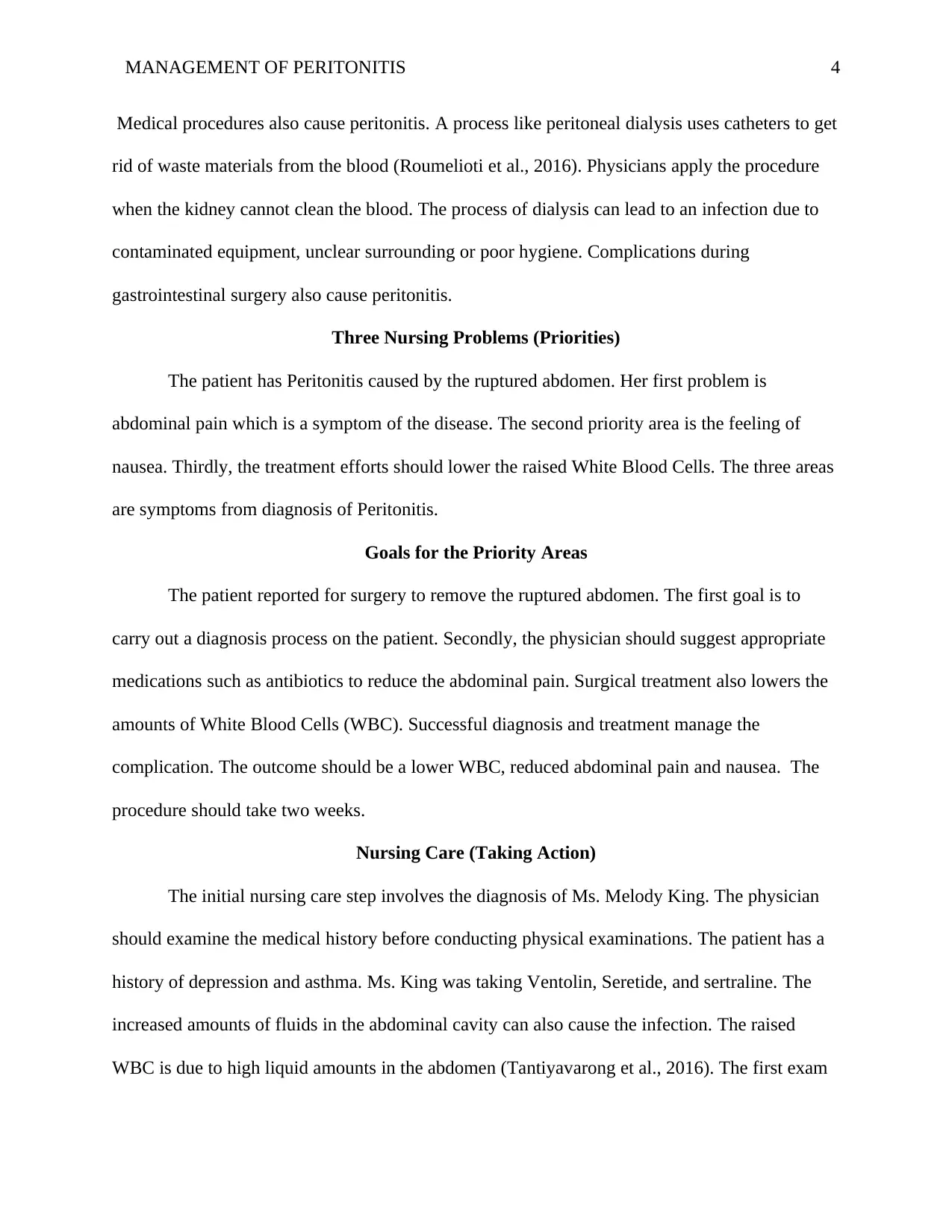
MANAGEMENT OF PERITONITIS 4
Medical procedures also cause peritonitis. A process like peritoneal dialysis uses catheters to get
rid of waste materials from the blood (Roumelioti et al., 2016). Physicians apply the procedure
when the kidney cannot clean the blood. The process of dialysis can lead to an infection due to
contaminated equipment, unclear surrounding or poor hygiene. Complications during
gastrointestinal surgery also cause peritonitis.
Three Nursing Problems (Priorities)
The patient has Peritonitis caused by the ruptured abdomen. Her first problem is
abdominal pain which is a symptom of the disease. The second priority area is the feeling of
nausea. Thirdly, the treatment efforts should lower the raised White Blood Cells. The three areas
are symptoms from diagnosis of Peritonitis.
Goals for the Priority Areas
The patient reported for surgery to remove the ruptured abdomen. The first goal is to
carry out a diagnosis process on the patient. Secondly, the physician should suggest appropriate
medications such as antibiotics to reduce the abdominal pain. Surgical treatment also lowers the
amounts of White Blood Cells (WBC). Successful diagnosis and treatment manage the
complication. The outcome should be a lower WBC, reduced abdominal pain and nausea. The
procedure should take two weeks.
Nursing Care (Taking Action)
The initial nursing care step involves the diagnosis of Ms. Melody King. The physician
should examine the medical history before conducting physical examinations. The patient has a
history of depression and asthma. Ms. King was taking Ventolin, Seretide, and sertraline. The
increased amounts of fluids in the abdominal cavity can also cause the infection. The raised
WBC is due to high liquid amounts in the abdomen (Tantiyavarong et al., 2016). The first exam
Medical procedures also cause peritonitis. A process like peritoneal dialysis uses catheters to get
rid of waste materials from the blood (Roumelioti et al., 2016). Physicians apply the procedure
when the kidney cannot clean the blood. The process of dialysis can lead to an infection due to
contaminated equipment, unclear surrounding or poor hygiene. Complications during
gastrointestinal surgery also cause peritonitis.
Three Nursing Problems (Priorities)
The patient has Peritonitis caused by the ruptured abdomen. Her first problem is
abdominal pain which is a symptom of the disease. The second priority area is the feeling of
nausea. Thirdly, the treatment efforts should lower the raised White Blood Cells. The three areas
are symptoms from diagnosis of Peritonitis.
Goals for the Priority Areas
The patient reported for surgery to remove the ruptured abdomen. The first goal is to
carry out a diagnosis process on the patient. Secondly, the physician should suggest appropriate
medications such as antibiotics to reduce the abdominal pain. Surgical treatment also lowers the
amounts of White Blood Cells (WBC). Successful diagnosis and treatment manage the
complication. The outcome should be a lower WBC, reduced abdominal pain and nausea. The
procedure should take two weeks.
Nursing Care (Taking Action)
The initial nursing care step involves the diagnosis of Ms. Melody King. The physician
should examine the medical history before conducting physical examinations. The patient has a
history of depression and asthma. Ms. King was taking Ventolin, Seretide, and sertraline. The
increased amounts of fluids in the abdominal cavity can also cause the infection. The raised
WBC is due to high liquid amounts in the abdomen (Tantiyavarong et al., 2016). The first exam
Secure Best Marks with AI Grader
Need help grading? Try our AI Grader for instant feedback on your assignments.
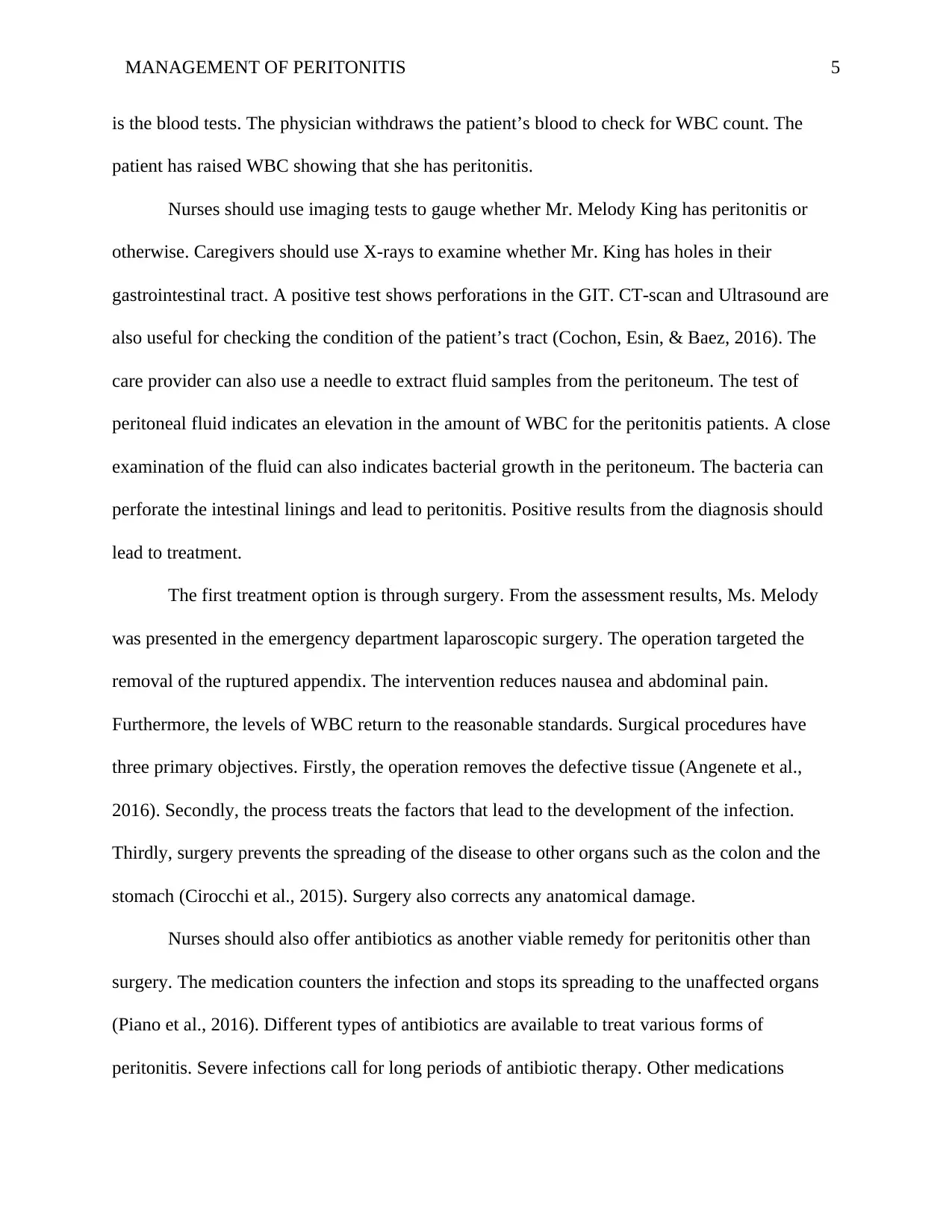
MANAGEMENT OF PERITONITIS 5
is the blood tests. The physician withdraws the patient’s blood to check for WBC count. The
patient has raised WBC showing that she has peritonitis.
Nurses should use imaging tests to gauge whether Mr. Melody King has peritonitis or
otherwise. Caregivers should use X-rays to examine whether Mr. King has holes in their
gastrointestinal tract. A positive test shows perforations in the GIT. CT-scan and Ultrasound are
also useful for checking the condition of the patient’s tract (Cochon, Esin, & Baez, 2016). The
care provider can also use a needle to extract fluid samples from the peritoneum. The test of
peritoneal fluid indicates an elevation in the amount of WBC for the peritonitis patients. A close
examination of the fluid can also indicates bacterial growth in the peritoneum. The bacteria can
perforate the intestinal linings and lead to peritonitis. Positive results from the diagnosis should
lead to treatment.
The first treatment option is through surgery. From the assessment results, Ms. Melody
was presented in the emergency department laparoscopic surgery. The operation targeted the
removal of the ruptured appendix. The intervention reduces nausea and abdominal pain.
Furthermore, the levels of WBC return to the reasonable standards. Surgical procedures have
three primary objectives. Firstly, the operation removes the defective tissue (Angenete et al.,
2016). Secondly, the process treats the factors that lead to the development of the infection.
Thirdly, surgery prevents the spreading of the disease to other organs such as the colon and the
stomach (Cirocchi et al., 2015). Surgery also corrects any anatomical damage.
Nurses should also offer antibiotics as another viable remedy for peritonitis other than
surgery. The medication counters the infection and stops its spreading to the unaffected organs
(Piano et al., 2016). Different types of antibiotics are available to treat various forms of
peritonitis. Severe infections call for long periods of antibiotic therapy. Other medications
is the blood tests. The physician withdraws the patient’s blood to check for WBC count. The
patient has raised WBC showing that she has peritonitis.
Nurses should use imaging tests to gauge whether Mr. Melody King has peritonitis or
otherwise. Caregivers should use X-rays to examine whether Mr. King has holes in their
gastrointestinal tract. A positive test shows perforations in the GIT. CT-scan and Ultrasound are
also useful for checking the condition of the patient’s tract (Cochon, Esin, & Baez, 2016). The
care provider can also use a needle to extract fluid samples from the peritoneum. The test of
peritoneal fluid indicates an elevation in the amount of WBC for the peritonitis patients. A close
examination of the fluid can also indicates bacterial growth in the peritoneum. The bacteria can
perforate the intestinal linings and lead to peritonitis. Positive results from the diagnosis should
lead to treatment.
The first treatment option is through surgery. From the assessment results, Ms. Melody
was presented in the emergency department laparoscopic surgery. The operation targeted the
removal of the ruptured appendix. The intervention reduces nausea and abdominal pain.
Furthermore, the levels of WBC return to the reasonable standards. Surgical procedures have
three primary objectives. Firstly, the operation removes the defective tissue (Angenete et al.,
2016). Secondly, the process treats the factors that lead to the development of the infection.
Thirdly, surgery prevents the spreading of the disease to other organs such as the colon and the
stomach (Cirocchi et al., 2015). Surgery also corrects any anatomical damage.
Nurses should also offer antibiotics as another viable remedy for peritonitis other than
surgery. The medication counters the infection and stops its spreading to the unaffected organs
(Piano et al., 2016). Different types of antibiotics are available to treat various forms of
peritonitis. Severe infections call for long periods of antibiotic therapy. Other medications
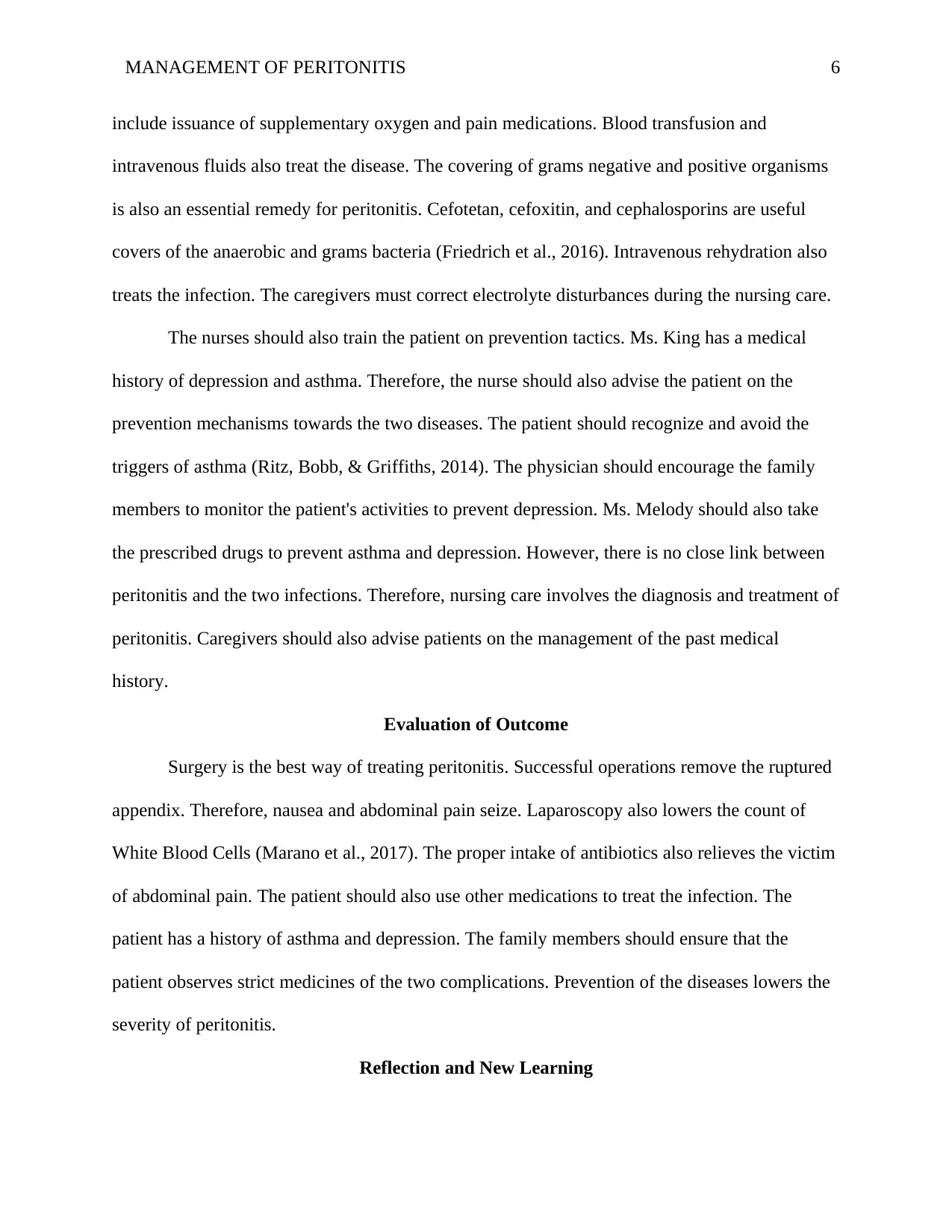
MANAGEMENT OF PERITONITIS 6
include issuance of supplementary oxygen and pain medications. Blood transfusion and
intravenous fluids also treat the disease. The covering of grams negative and positive organisms
is also an essential remedy for peritonitis. Cefotetan, cefoxitin, and cephalosporins are useful
covers of the anaerobic and grams bacteria (Friedrich et al., 2016). Intravenous rehydration also
treats the infection. The caregivers must correct electrolyte disturbances during the nursing care.
The nurses should also train the patient on prevention tactics. Ms. King has a medical
history of depression and asthma. Therefore, the nurse should also advise the patient on the
prevention mechanisms towards the two diseases. The patient should recognize and avoid the
triggers of asthma (Ritz, Bobb, & Griffiths, 2014). The physician should encourage the family
members to monitor the patient's activities to prevent depression. Ms. Melody should also take
the prescribed drugs to prevent asthma and depression. However, there is no close link between
peritonitis and the two infections. Therefore, nursing care involves the diagnosis and treatment of
peritonitis. Caregivers should also advise patients on the management of the past medical
history.
Evaluation of Outcome
Surgery is the best way of treating peritonitis. Successful operations remove the ruptured
appendix. Therefore, nausea and abdominal pain seize. Laparoscopy also lowers the count of
White Blood Cells (Marano et al., 2017). The proper intake of antibiotics also relieves the victim
of abdominal pain. The patient should also use other medications to treat the infection. The
patient has a history of asthma and depression. The family members should ensure that the
patient observes strict medicines of the two complications. Prevention of the diseases lowers the
severity of peritonitis.
Reflection and New Learning
include issuance of supplementary oxygen and pain medications. Blood transfusion and
intravenous fluids also treat the disease. The covering of grams negative and positive organisms
is also an essential remedy for peritonitis. Cefotetan, cefoxitin, and cephalosporins are useful
covers of the anaerobic and grams bacteria (Friedrich et al., 2016). Intravenous rehydration also
treats the infection. The caregivers must correct electrolyte disturbances during the nursing care.
The nurses should also train the patient on prevention tactics. Ms. King has a medical
history of depression and asthma. Therefore, the nurse should also advise the patient on the
prevention mechanisms towards the two diseases. The patient should recognize and avoid the
triggers of asthma (Ritz, Bobb, & Griffiths, 2014). The physician should encourage the family
members to monitor the patient's activities to prevent depression. Ms. Melody should also take
the prescribed drugs to prevent asthma and depression. However, there is no close link between
peritonitis and the two infections. Therefore, nursing care involves the diagnosis and treatment of
peritonitis. Caregivers should also advise patients on the management of the past medical
history.
Evaluation of Outcome
Surgery is the best way of treating peritonitis. Successful operations remove the ruptured
appendix. Therefore, nausea and abdominal pain seize. Laparoscopy also lowers the count of
White Blood Cells (Marano et al., 2017). The proper intake of antibiotics also relieves the victim
of abdominal pain. The patient should also use other medications to treat the infection. The
patient has a history of asthma and depression. The family members should ensure that the
patient observes strict medicines of the two complications. Prevention of the diseases lowers the
severity of peritonitis.
Reflection and New Learning

MANAGEMENT OF PERITONITIS 7
There are a lot of learning points from the management of peritonitis. The first lesson is
that the elevation of the WBC is an indication of the infection. Secondly, nausea and abdominal
pain are the dominant symptoms of the disease. Surgery to remove the ruptured appendix is
essential in treating the disease. Antibiotics and other medications also lower the abdominal pain
due to peritonitis (Piraino, 2017). The nurse must conduct a proper diagnosis before the
treatment process. X-rays and CT-scans are useful in checking for holes in the gastrointestinal
tract. An individual who shows a raised WBC has high chances of peritonitis.
Conclusion
Ms. Melody King is a 36-year old who has peritonitis due to the ruptured abdomen.
Clinical Reasoning Cycle is useful in providing a person-centered treatment to the patient. The
first step is to consider the situation of the patient. The action involves documenting the facts
about Ms. King. The patient reports to the emergency department to undergo surgery. The
operation intends to remove the ruptured abdomen. The second step is to collect information
about the patient. The stage discusses the pathology and the causes of the infection.
Processing of information and identification of the issues are the next steps in the Clinical
Reasoning cycle. The caregiver then establishes goals of tackling the priority areas. The critical
issues in the case study are the symptoms which include abdominal pain, nausea, and raised
WBC. The care provider then takes action to rectify the problems. The effect refers to the
nursing care involving diagnosis and treatment. Evaluation and reflection are the last steps in the
cycle.
There are a lot of learning points from the management of peritonitis. The first lesson is
that the elevation of the WBC is an indication of the infection. Secondly, nausea and abdominal
pain are the dominant symptoms of the disease. Surgery to remove the ruptured appendix is
essential in treating the disease. Antibiotics and other medications also lower the abdominal pain
due to peritonitis (Piraino, 2017). The nurse must conduct a proper diagnosis before the
treatment process. X-rays and CT-scans are useful in checking for holes in the gastrointestinal
tract. An individual who shows a raised WBC has high chances of peritonitis.
Conclusion
Ms. Melody King is a 36-year old who has peritonitis due to the ruptured abdomen.
Clinical Reasoning Cycle is useful in providing a person-centered treatment to the patient. The
first step is to consider the situation of the patient. The action involves documenting the facts
about Ms. King. The patient reports to the emergency department to undergo surgery. The
operation intends to remove the ruptured abdomen. The second step is to collect information
about the patient. The stage discusses the pathology and the causes of the infection.
Processing of information and identification of the issues are the next steps in the Clinical
Reasoning cycle. The caregiver then establishes goals of tackling the priority areas. The critical
issues in the case study are the symptoms which include abdominal pain, nausea, and raised
WBC. The care provider then takes action to rectify the problems. The effect refers to the
nursing care involving diagnosis and treatment. Evaluation and reflection are the last steps in the
cycle.
Paraphrase This Document
Need a fresh take? Get an instant paraphrase of this document with our AI Paraphraser
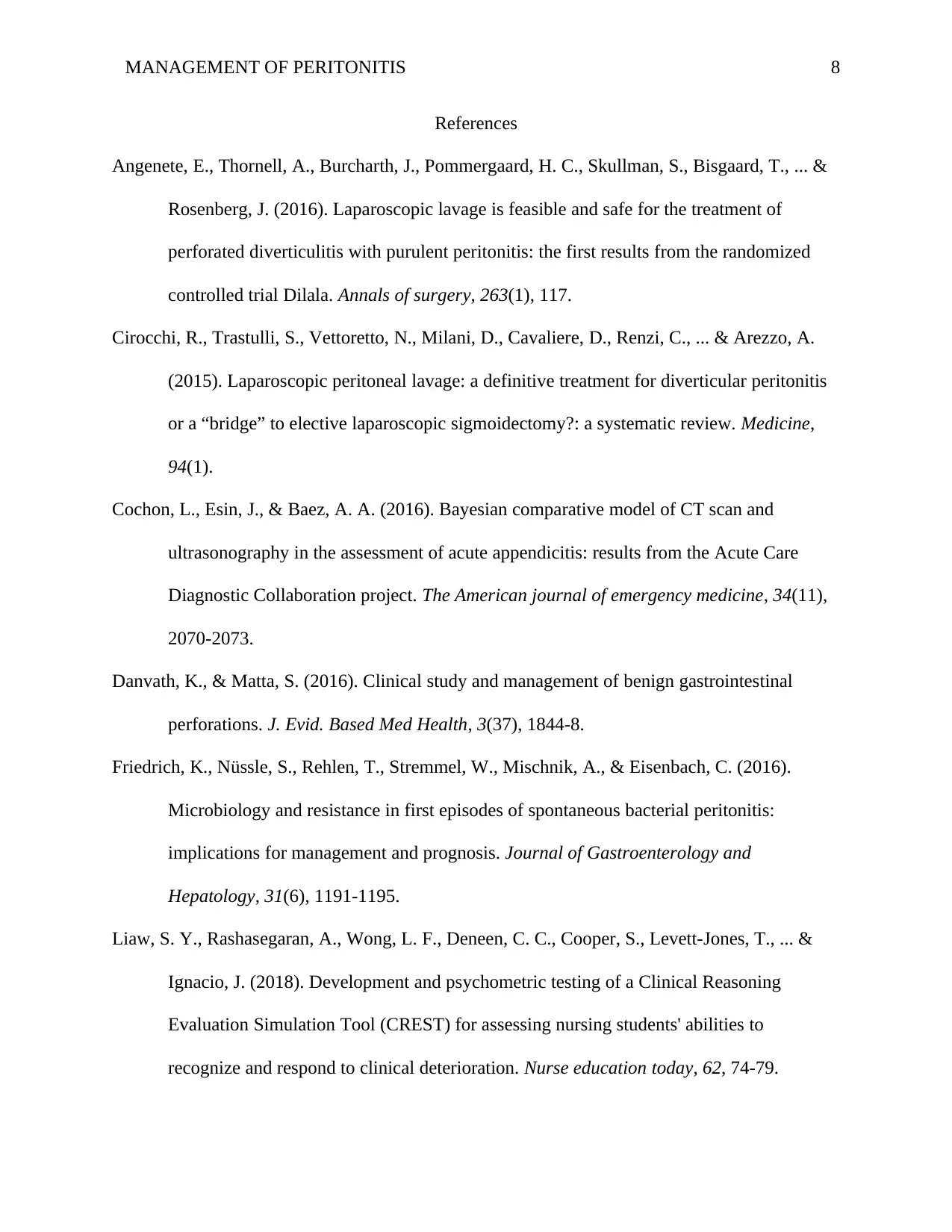
MANAGEMENT OF PERITONITIS 8
References
Angenete, E., Thornell, A., Burcharth, J., Pommergaard, H. C., Skullman, S., Bisgaard, T., ... &
Rosenberg, J. (2016). Laparoscopic lavage is feasible and safe for the treatment of
perforated diverticulitis with purulent peritonitis: the first results from the randomized
controlled trial Dilala. Annals of surgery, 263(1), 117.
Cirocchi, R., Trastulli, S., Vettoretto, N., Milani, D., Cavaliere, D., Renzi, C., ... & Arezzo, A.
(2015). Laparoscopic peritoneal lavage: a definitive treatment for diverticular peritonitis
or a “bridge” to elective laparoscopic sigmoidectomy?: a systematic review. Medicine,
94(1).
Cochon, L., Esin, J., & Baez, A. A. (2016). Bayesian comparative model of CT scan and
ultrasonography in the assessment of acute appendicitis: results from the Acute Care
Diagnostic Collaboration project. The American journal of emergency medicine, 34(11),
2070-2073.
Danvath, K., & Matta, S. (2016). Clinical study and management of benign gastrointestinal
perforations. J. Evid. Based Med Health, 3(37), 1844-8.
Friedrich, K., Nüssle, S., Rehlen, T., Stremmel, W., Mischnik, A., & Eisenbach, C. (2016).
Microbiology and resistance in first episodes of spontaneous bacterial peritonitis:
implications for management and prognosis. Journal of Gastroenterology and
Hepatology, 31(6), 1191-1195.
Liaw, S. Y., Rashasegaran, A., Wong, L. F., Deneen, C. C., Cooper, S., Levett-Jones, T., ... &
Ignacio, J. (2018). Development and psychometric testing of a Clinical Reasoning
Evaluation Simulation Tool (CREST) for assessing nursing students' abilities to
recognize and respond to clinical deterioration. Nurse education today, 62, 74-79.
References
Angenete, E., Thornell, A., Burcharth, J., Pommergaard, H. C., Skullman, S., Bisgaard, T., ... &
Rosenberg, J. (2016). Laparoscopic lavage is feasible and safe for the treatment of
perforated diverticulitis with purulent peritonitis: the first results from the randomized
controlled trial Dilala. Annals of surgery, 263(1), 117.
Cirocchi, R., Trastulli, S., Vettoretto, N., Milani, D., Cavaliere, D., Renzi, C., ... & Arezzo, A.
(2015). Laparoscopic peritoneal lavage: a definitive treatment for diverticular peritonitis
or a “bridge” to elective laparoscopic sigmoidectomy?: a systematic review. Medicine,
94(1).
Cochon, L., Esin, J., & Baez, A. A. (2016). Bayesian comparative model of CT scan and
ultrasonography in the assessment of acute appendicitis: results from the Acute Care
Diagnostic Collaboration project. The American journal of emergency medicine, 34(11),
2070-2073.
Danvath, K., & Matta, S. (2016). Clinical study and management of benign gastrointestinal
perforations. J. Evid. Based Med Health, 3(37), 1844-8.
Friedrich, K., Nüssle, S., Rehlen, T., Stremmel, W., Mischnik, A., & Eisenbach, C. (2016).
Microbiology and resistance in first episodes of spontaneous bacterial peritonitis:
implications for management and prognosis. Journal of Gastroenterology and
Hepatology, 31(6), 1191-1195.
Liaw, S. Y., Rashasegaran, A., Wong, L. F., Deneen, C. C., Cooper, S., Levett-Jones, T., ... &
Ignacio, J. (2018). Development and psychometric testing of a Clinical Reasoning
Evaluation Simulation Tool (CREST) for assessing nursing students' abilities to
recognize and respond to clinical deterioration. Nurse education today, 62, 74-79.

MANAGEMENT OF PERITONITIS 9
Marano, A., Giuffrida, M. C., Giraudo, G., Pellegrino, L., & Borghi, F. (2017). Management of
Peritonitis After Minimally Invasive Colorectal Surgery: Can We Stick to Laparoscopy?.
Journal of Laparoendoscopic & Advanced Surgical Techniques, 27(4), 342-347.
Metcalfe, D., Sugand, K., Thrumurthy, S. G., Thompson, M. M., Holt, P. J., &
Karthikesalingam, A. P. (2016). Diagnosis of ruptured abdominal aortic aneurysm: a
multicentre cohort study. European Journal of Emergency Medicine, 23(5), 386-390.
Piano, S., Fasolato, S., Salinas, F., Romano, A., Tonon, M., Morando, F., ... & Palù, G. (2016).
The empirical antibiotic treatment of nosocomial spontaneous bacterial peritonitis:
Results of a randomized, controlled clinical trial. Hepatology, 63(4), 1299-1309.
Piraino, B. (2017). Effective Treatment of PD Peritonitis. Clinical Journal of the American
Society of Nephrology, 12(12), 1919-1921.
Ramachandra, M. L. (2017). Age, sex incidence with signs and symptoms of peritonitis.
International Journal of Research in Medical Sciences, 2(3), 916-919.
Ritz, T., Bobb, C., & Griffiths, C. (2014, September). Predicting asthma control: the role of
psychological triggers. In Allergy and asthma proceedings (Vol. 35, No. 5, pp. 390-397).
OceanSide Publications, Inc.
Roumelioti, M. E., Argyropoulos, C., Pankratz, V. S., Jhamb, M., Bender, F. H., Buysse, D. J., ...
& Unruh, M. L. (2016). Objective and subjective sleep disorders in automated peritoneal
dialysis. Canadian Journal of kidney health and disease, 3(1), 6.
Sato, K., Tazawa, H., Fujisaki, S., Fukuhara, S., Imaoka, K., Hirata, Y., ... & Sakimoto, H.
(2017). Acute diffuse peritonitis due to spontaneous rupture of a primary gastrointestinal
stromal tumor of the jejunum: A case report. International journal of surgery case
reports, 39, 288-292.
Marano, A., Giuffrida, M. C., Giraudo, G., Pellegrino, L., & Borghi, F. (2017). Management of
Peritonitis After Minimally Invasive Colorectal Surgery: Can We Stick to Laparoscopy?.
Journal of Laparoendoscopic & Advanced Surgical Techniques, 27(4), 342-347.
Metcalfe, D., Sugand, K., Thrumurthy, S. G., Thompson, M. M., Holt, P. J., &
Karthikesalingam, A. P. (2016). Diagnosis of ruptured abdominal aortic aneurysm: a
multicentre cohort study. European Journal of Emergency Medicine, 23(5), 386-390.
Piano, S., Fasolato, S., Salinas, F., Romano, A., Tonon, M., Morando, F., ... & Palù, G. (2016).
The empirical antibiotic treatment of nosocomial spontaneous bacterial peritonitis:
Results of a randomized, controlled clinical trial. Hepatology, 63(4), 1299-1309.
Piraino, B. (2017). Effective Treatment of PD Peritonitis. Clinical Journal of the American
Society of Nephrology, 12(12), 1919-1921.
Ramachandra, M. L. (2017). Age, sex incidence with signs and symptoms of peritonitis.
International Journal of Research in Medical Sciences, 2(3), 916-919.
Ritz, T., Bobb, C., & Griffiths, C. (2014, September). Predicting asthma control: the role of
psychological triggers. In Allergy and asthma proceedings (Vol. 35, No. 5, pp. 390-397).
OceanSide Publications, Inc.
Roumelioti, M. E., Argyropoulos, C., Pankratz, V. S., Jhamb, M., Bender, F. H., Buysse, D. J., ...
& Unruh, M. L. (2016). Objective and subjective sleep disorders in automated peritoneal
dialysis. Canadian Journal of kidney health and disease, 3(1), 6.
Sato, K., Tazawa, H., Fujisaki, S., Fukuhara, S., Imaoka, K., Hirata, Y., ... & Sakimoto, H.
(2017). Acute diffuse peritonitis due to spontaneous rupture of a primary gastrointestinal
stromal tumor of the jejunum: A case report. International journal of surgery case
reports, 39, 288-292.
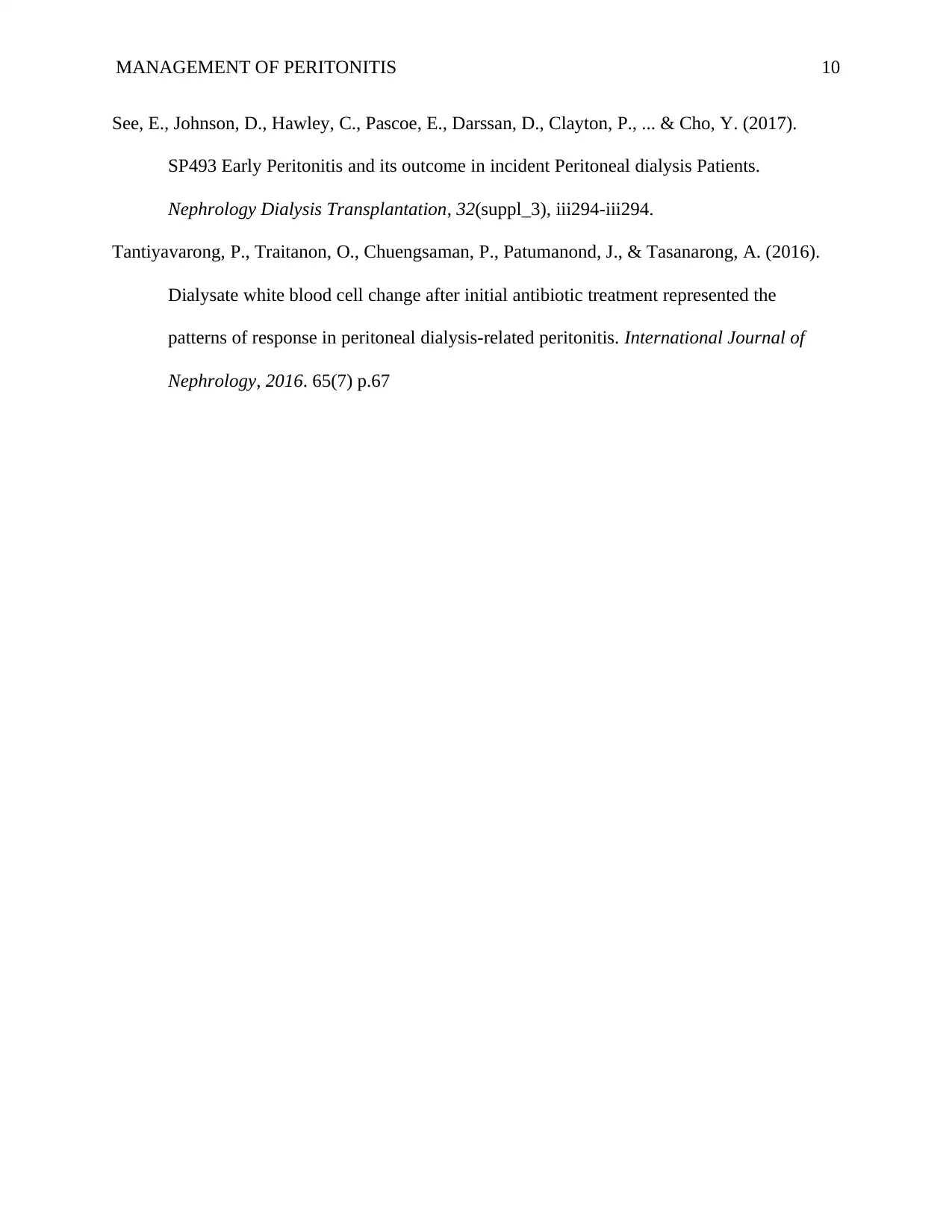
MANAGEMENT OF PERITONITIS 10
See, E., Johnson, D., Hawley, C., Pascoe, E., Darssan, D., Clayton, P., ... & Cho, Y. (2017).
SP493 Early Peritonitis and its outcome in incident Peritoneal dialysis Patients.
Nephrology Dialysis Transplantation, 32(suppl_3), iii294-iii294.
Tantiyavarong, P., Traitanon, O., Chuengsaman, P., Patumanond, J., & Tasanarong, A. (2016).
Dialysate white blood cell change after initial antibiotic treatment represented the
patterns of response in peritoneal dialysis-related peritonitis. International Journal of
Nephrology, 2016. 65(7) p.67
See, E., Johnson, D., Hawley, C., Pascoe, E., Darssan, D., Clayton, P., ... & Cho, Y. (2017).
SP493 Early Peritonitis and its outcome in incident Peritoneal dialysis Patients.
Nephrology Dialysis Transplantation, 32(suppl_3), iii294-iii294.
Tantiyavarong, P., Traitanon, O., Chuengsaman, P., Patumanond, J., & Tasanarong, A. (2016).
Dialysate white blood cell change after initial antibiotic treatment represented the
patterns of response in peritoneal dialysis-related peritonitis. International Journal of
Nephrology, 2016. 65(7) p.67
1 out of 10
Related Documents
Your All-in-One AI-Powered Toolkit for Academic Success.
+13062052269
info@desklib.com
Available 24*7 on WhatsApp / Email
![[object Object]](/_next/static/media/star-bottom.7253800d.svg)
Unlock your academic potential
© 2024 | Zucol Services PVT LTD | All rights reserved.





